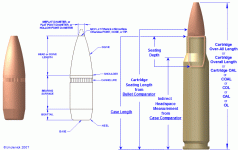"Technically the term CBTO should mean from the cartridge base to the point where the bearing surface ends and the Ogive begins."
My opinion is, that is what everyone who uses the term, "ogive," means to the user.
Is there any value in handloading to know or use the true definition of "the ogive of a bullet is the ENTIRE sloped / curved portion of the bullet from the point where it reduces down from full diameter, all the way to the tip of the bullet, which we call the meplat".
An obstacle to learning new things is to be stuck on the idea you are right.
"The compass is broke" as you confidently head deeper into the swamp.
I tend to use bullets that are better at retaining velocity. Or,bullets with higher ballistic coefficient. Those characteristics are largely defined by the base (boat tail) and the ogive. That is the part that matters to me.
I load to functional magazine length.
Unless we are single loading long,heavy for caliber bullets,in excess of magazine length, a high ballistic coefficient bullet is unikely to contact the rifling because the ogive is too skinny in most cases.
IMO,it just does not compute to think the word "ogive" implies the contact point with the rifling.
Remember,the contact diameter will be something close to bore diameter.
You said something about "CBTO" being cartridge base to end of the cylindrical bearing diameter of the bullet.
I accept that definition.That would be at full bullet diameter,which is typically about barrel groove diameter,not bore diameter.
The rifling might contact at bore diameter,or any place along the leade taper.
It would not be unusual for the difference to be about .005 on the barrel diameters.
On a tangent ogive bullet,.005 diameter might translate to significant length.
Last edited:

